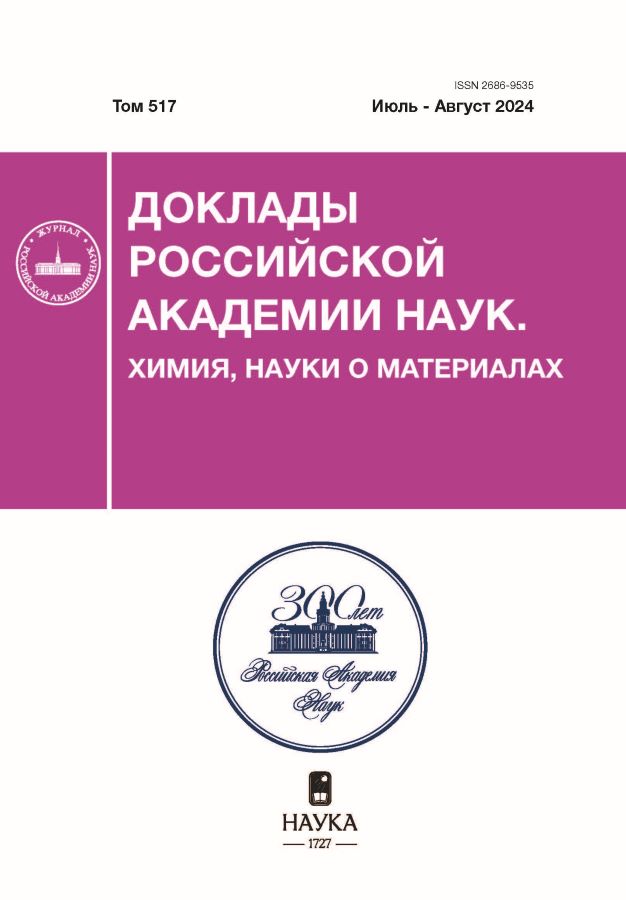Kinetic Regularities of Nanogold Synthesis. Auto-Catalytic Mechanism of the Process
- Авторлар: Varfolomeev S.D.1,2, Kalinichenko V.N.2, Kuznetsov Y.A.3, Gachok I.V.1, Tsybenova S.B.2
-
Мекемелер:
- Lomonosov Moscow State University
- Emanuel Institute of Biochemical Physics, Russian Academy of Sciences
- LLC “RG Irkutskgeophysics 3”
- Шығарылым: Том 517, № 1 (2024)
- Беттер: 33-38
- Бөлім: PHYSICAL CHEMISTRY
- URL: https://ter-arkhiv.ru/2686-9535/article/view/651901
- DOI: https://doi.org/10.31857/S2686953524040049
- EDN: https://elibrary.ru/YDXXPO
- ID: 651901
Дәйексөз келтіру
Аннотация
The work is devoted to the study of the kinetics of colloidal gold formation. On the basis of experimental data, a kinetic model including the stages of Au3+ and Au1+ reduction with the formation of metallic gold nanoparticles was developed. A kinetic feature of the process is the presence of a long induction period (several hours), while an increase in the induction period is observed with increasing concentration of the initial reagent (Au3+). Kinetic modeling shows that the induction period is determined by the process of reverse oxidation of Au0 with intermediate formation of one-electron oxidized gold. The principal result is the demonstration of the fact of acceleration of the process gold nanoparticles formation (reduction of the induction period) when the final product (Au0) is introduced into the system, which is an unambiguous sign of the autocatalytic process. Estimates of rate constants of all elementary stages of the reaction have been made, the slowest process being the first stage of Au3+ reduction.
Негізгі сөздер
Толық мәтін
Авторлар туралы
S. Varfolomeev
Lomonosov Moscow State University; Emanuel Institute of Biochemical Physics, Russian Academy of Sciences
Email: s.tsybenova@gmail.com
Corresponding Member of the RAS, Institute of Physicochemical Foundations of the Functioning of Neural Network and Artificial Intellegence, Department of Chemistry
Ресей, 119991 Moscow; 119334 MoscowV. Kalinichenko
Emanuel Institute of Biochemical Physics, Russian Academy of Sciences
Email: s.tsybenova@gmail.com
Ресей, 119334 Moscow
Yu. Kuznetsov
LLC “RG Irkutskgeophysics 3”
Email: s.tsybenova@gmail.com
Ресей, 664039 Irkutsk
I. Gachok
Lomonosov Moscow State University
Email: s.tsybenova@gmail.com
Department of Chemistry
Ресей, 119991 MoscowS. Tsybenova
Emanuel Institute of Biochemical Physics, Russian Academy of Sciences
Хат алмасуға жауапты Автор.
Email: s.tsybenova@gmail.com
Ресей, 119334 Moscow
Әдебиет тізімі
- Faraday M. Experimental researches in chemistry and physics. London, Taylor & Francis, 1859. 496 p.
- Сергеев Г.Б. Нанохимия: учеб. пособие. М.: КДУ, 2015. 284 с.
- Lo Nigro R., Fiorenza P., Pécz B., Eriksson J. // Nanomaterials. 2022. V. 12. № 19. P. 3319 https://doi.org/10.3390/nano12193319
- Апяри В.В., Дмитриенко С.Г., Горбунова М.В., Фурлетов А.А., Золотов Ю.А. // Журн. аналит. химии. 2019. Т. 74. № 1. С. 26‒38. https://doi.org/10.1134/S0044450219010055
- Дурович Е.А., Евтушенко Е.Г., Сенько О.В., Степанов Н.А., Ефременко Е.Н., Еременко А.В., Курочкин И.Н. // Вестник РГМУ. 2018. № 6. С. 27–35. https://doi.org/10.24075/vrgmu.2018.088
- Варфоломеев С.Д. Молекулярные основы интеллекта. М.: МГУ, 2024. 290 с.
- Коршунов А.В., Кашкан Г.В., Нгуен Х.Т.Т., Зыонг Ш.В. // Изв. ТПУ. 2011. Т. 318. № 3. С. 12‒18. http://earchive.tpu.ru/handle/11683/3644
- Haruta M. // Gold Bull. 2004. V. 37. P. 27–36. https://doi.org/10.1007/BF03215514
- Hutchings G.J. Catalysis by gold: Recent advances in oxidation reactions. In: Nanotechnology in catalysis. Nanostructure science and technology. Zhou B., Han S., Raja R., Somorjai G.A. (eds.). Springer, New York, NY, 2007. pp. 39–54. https://doi.org/10.1007/978-0-387-34688-5_4
- Turkevich J., Stevenson P.C., Hillier J. // Discuss. Faraday Soc. 1951. V. 11. P. 55–75. https://doi.org/10.1039/DF9511100055
- Polte J., Ahner T.T., Delissen F., Sokolov S., Emmerling F., Thünemann A.F., Kraehnert R. // J. Amer. Chem. Soc. 2010. V. 132. № 4. P. 1296–1301. https://doi.org/10.1021/ja906506j
- Patungwasa W., Hodak J.H. // Mater. Chem. Phys. 2008. V. 108. № 1. P. 45–54. https://doi.org/10.1016/j.matchemphys.2007.09.001
- Ахметов Н.С. Неорганическая химия. М.: Высшая школа. 1975. 672 с.
- Варфоломеев С.Д. Динамика неустойчивости. Кинетическое моделирование и методы управления. М.: Научный мир. 2021. 282 с.
Қосымша файлдар
















